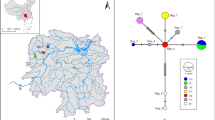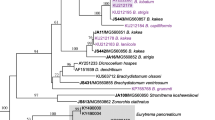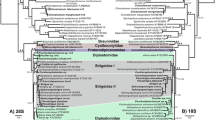Abstract
Diplostomum ardeae Dubois, 1969 has seldom been reported since its description from the great blue heron (Ardea herodias L., 1758) in the USA. Sequences obtained in this study from the barcode region of cytochrome c oxidase 1 (CO1) in diplostomids from black-crowned night heron (Nycticorax nycticorax (L., 1758)) in Puerto Rico matched data from D. ardeae from A. herodias in the type region. We also obtained DNA barcodes from morphologically similar diplostomids from a rufescent tiger heron (Tigrisoma lineatum (Boddaert, 1783)) and from metacercariae from eye lenses of Trachelyopterus galeatus (Linnaeus, 1766) from the Paraná River basin in Argentina and Brazil, respectively. Barcodes matched (97–100% identity) in these South American adult and larval specimens as well as in recently published sequences from metacercariae from 11 other siluriform fishes from the same region. Barcodes from the South American species, which we describe as Diplostomum lunaschiae n. sp., differed from those of D. ardeae by 7.2–9.8%, and the new species differs from D. ardeae in its size, pharynx:oral sucker length ratio, egg:body length ratio, and distribution of vitellaria. As in prior phylogenetic analysis of CO1 sequences, both D. ardeae and D. lunaschiae n. sp. were not associated with Diplostomum. In more character-rich analyses of nuclear rDNA and of mitochondrial genomes, D. ardeae was an early divergent member of clades of species of Diplostomum. Consequently, we continue to consider D. ardeae and D. lunaschiae n. sp. members of Diplostomum, in contrast to recent suggestions that these species may belong to a different genus.






Similar content being viewed by others
Data availability
Nucleotide sequences reported here are available in GenBank (D. ardeae mitochondrial genome MT259035 and rDNA operon MT259036; D. ardeae and D. lunaschiae n. sp. CO1 DNA barcodes MT324592-626), and vouchers have been deposited at the Museum of Southwestern Biology (MSB: Para:30692-3) and Museo de La Plata (MLP-He 7656).
References
Acosta AA, Smit NJ, da Silva RJ (2020) Diversity of helminth parasites of eight siluriform fishes from the Aguapeí River, Upper Paraná basin, São Paulo State, Brazil. Int J Parasitol Parasites Wildl 11:120–128. https://doi.org/10.1016/j.ijppaw.2020.01.003
Bernt M, Donath A, Jühling F, Externbrink F, Florentz C, Fritzsch G, Pütz J, Middendorf M, Stadler PF (2013) MITOS: improved de novo metazoan mitochondrial genome annotation. Mol Phylogenet Evol 69:313–319. https://doi.org/10.1016/j.ympev.2012.08.023
Bunkley-Williams L, Williams EH (1994) Parasites of Puerto Rican freshwater sport fishes. Puerto Rico Department of Natural and Environmental Resources, San Juan, PR and Department of Marine Sciences, University of Puerto Rico, Mayaguez, PR, 168 pp
Dronen NO, Chen W-C (2002) Endohelminths from the little blue heron Egretta caerulea from the Texas Gulf Coast. Comp Parasitol 69:96–99. https://doi.org/10.1654/1525-2647(2002)069[0096:EFTLBH]2.0.CO;2
Dubois G (1969) Les Strigeata (Trematoda) de la collection Elizabeth M. Boyd. Bull. Société Neuchâtel Sci Nat 92:5–12. https://doi.org/10.5169/seals-88991
Dubois G (1970) Synopsis des Strigeidae et des Diplostomatidae (Trematoda). Mém Société Neuchâtel Sci Nat 10:1–727
Dubois G, Angel M (1972) Strigeata of Australian birds and mammals from the helminthological collection of the University of Adelaide. Trans R Soc S Aust 96:197–215
El-Naffar M, Khalifa R, Sakla A (1980) Parasitofauna of the Egyptian aquatic birds. II. Trematode parasites of the giant heron (Ardea goliath) in Assiut governorate. J Egypt Soc Parasitol 10:107–116
Gómez JP, López HL (2015) Dibujantes del Museo de La Plata: Luis Gerardo Pagano. ProBiota, Serie Arte y Sociedad en la Ictiología Nacional, 10:1–30
Graça WJ, Pavanelli CS (2007) Peixes da planície de inundação do alto rio Paraná e áreas adjacentes. EDUEM, Maringá
Hernández-Mena DI, García-Varela M, de León GP (2017) Filling the gaps in the classification of the Digenea Carus, 1863: systematic position of the Proterodiplostomidae Dubois, 1936 within the superfamily Diplostomoidea Poirier, 1886, inferred from nuclear and mitochondrial DNA sequences. Syst Parasitol 94:833–848. https://doi.org/10.1007/s11230-017-9745-1
Hoffman GL, Hundley JB (1957) The life-cycle of Diplostomum baeri eucaliae n. subsp. (Trematoda: Strigeida). J Parasitol 43:613–627
Huelsenbeck JP, Ronquist F (2001) MRBAYES: Bayesian inference of phylogenetic trees. Bioinformatics 17:754–755. https://doi.org/10.1093/bioinformatics/17.8.754
Kumar S, Stecher G, Li M, Knyaz C, Tamura K (2018) MEGA X: molecular evolutionary genetics analysis across computing platforms. Mol Biol Evol 35:1547–1549. https://doi.org/10.1093/molbev/msy096
Leite LAR, Pelegrini LS, Agostinho BN, Azevedo RK, Abdallah VD (2018) Biodiversity of the metazoan parasites of Prochilodus lineatus (Valenciennes, 1837) (Characiformes: Prochilodontidae) in anthropized environments from the Batalha River, São Paulo State, Brazil. Biot Neotrop 18:e20170422. https://doi.org/10.1590/1676-0611-BN-2017-0422
Locke SA, Al-Nasiri FS, Caffara M, Drago F, Kalbe M, Lapierre AR, McLaughlin JD, Nie P, Overstreet RM, Souza GT, Takemoto RM, Marcogliese DJ (2015) Diversity, specificity and speciation in larval Diplostomidae (Platyhelminthes: Digenea) in the eyes of freshwater fish, as revealed by DNA barcodes. Int J Parasitol 45:841–855. https://doi.org/10.1016/j.ijpara.2015.07.001
Moszczynska A, Locke SA, McLaughlin JD, Marcogliese DJ, Crease TJ (2009) Development of primers for the mitochondrial cytochrome c oxidase I gene in digenetic trematodes (Platyhelminthes) illustrates the challenge of barcoding parasitic helminths. Mol Ecol Resour 9:75–82. https://doi.org/10.1111/j.1755-0998.2009.02634.x
Neal JW, Lilyestrom CG, Kwak TJ (2009) Factors influencing tropical island freshwater fishes: species, status, and management implications in Puerto Rico. Fisheries. 34:546–554. https://doi.org/10.1577/1548-8446-34.11.546
Pelegrini LS, Gião T, Vieira DH, Müller MI, da Silva RJ, Pérez-Ponce de León G, de Azevedo RK, Abdallah VD (2019) Molecular and morphological characterization of the metacercariae of two species of diplostomid trematodes (Platyhelminthes, Digenea) in freshwater fishes of the Batalha River, Brazil. Parasitol Res 118:2169–2182. https://doi.org/10.1007/s00436-019-06362-2
Silvestro D, Michalak I (2012) raxmlGUI: a graphical front-end for RAxML. Org Divers Evol 12:335–337. https://doi.org/10.1007/s13127-011-0056-0
Stamatakis A (2014) RAxML version 8: a tool for phylogenetic analysis and post-analysis of large phylogenies. Bioinformatics 30:1312–1313. https://doi.org/10.1093/bioinformatics/btu033
Van der Schalie H (1948). The land and fresh-water mollusks of Puerto Rico. University of Michigan Press, Ann Arbor, 134 pp
Xia X, Lemey P (2009) Assessing substitution saturation with DAMBE. In: Lemey P, Salemi M, Vandamme A-M (eds) The phylogenetic handbook: a practical approach to phylogenetic analysis and hypothesis testing. Cambridge University Press, Cambridge, pp 615–630
Xia X, Xie Z, Salemi M, Chen L, Wang Y (2003) An index of substitution saturation and its application. Mol Phylogenet Evol 26:1–7. https://doi.org/10.1016/S1055-7903(02)00326-3
Acknowledgments
Three anonymous reviewers provided comments on earlier drafts that improved this article. Susan Wylie and staff at Le Nichoir, Hudson, Quebec, provided access to a salvaged carcass of A. herodias. Fieldwork in Formosa was conducted with Agustín M. Abba (CONICET) and our departed colleague and friend, Luis Gerardo Pagano (1985–2020), some of whose contributions are reviewed by Gómez and López (2015).
Funding
This study was financially supported by the Puerto Rico Science, Technology and Research Trust (grant 2016-00080); the National Science Foundation’s Division of Environmental Biology (grant 1845021); Paul D. N. Hebert (University of Guelph) through funding from NSERC, Genome Canada, the Ontario Genomics Institute and the International Barcode of Life; Universidad Nacional de La Plata (11/N896); the Comisión de Investigaciones Científicas de la provincia de Buenos Aires (Res. 597/16), Argentina; CAPES (Coordenação de Aperfeiçoamento de Pessoal de Nível Superior (process 13741-12-8); and the CNPq (Conselho Nacional de Desenvolvimento Científico e Tecnológico (process 480180/2011-3).
Author information
Authors and Affiliations
Corresponding author
Ethics declarations
Conflict of interest
The authors declare that they have no conflicts of interest.
Additional information
Section Editor: Guillermo Salgado-Maldonado
Publisher’s note
Springer Nature remains neutral with regard to jurisdictional claims in published maps and institutional affiliations.
Rights and permissions
About this article
Cite this article
Locke, S.A., Drago, F.B., Núñez, V. et al. Phylogenetic position of Diplostomum spp. from New World herons based on complete mitogenomes, rDNA operons, and DNA barcodes, including a new species with partially elucidated life cycle. Parasitol Res 119, 2129–2137 (2020). https://doi.org/10.1007/s00436-020-06713-4
Received:
Accepted:
Published:
Issue Date:
DOI: https://doi.org/10.1007/s00436-020-06713-4




